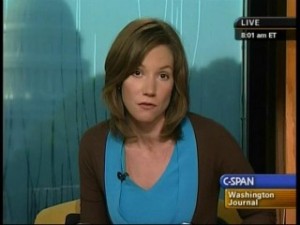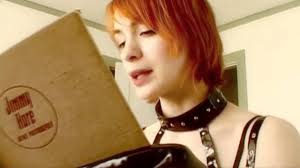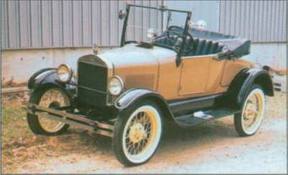If you don’t know who Felicia Day is, you are probably over twenty years in age, and/or spend fewer than ten hours per day on the Inter-Webs.
So, for you underprivileged minds: Felicia Day is a minor actress in her early 30s who has appeared in a couple of TV shows and feature films, as well as some internet-based video dramas that supposedly were very popular with people who like that sort of thing. She is originally from Huntsville, Alabama (which doesn’t mean anything at all, as we all know), went to University of Texas in Austin (ditto) and now lives in or around Los Angeles. She has dark red hair, helped along with various artificial colorings. Six months ago she cut it from waist-length to pixie-bob, which deeply distressed some of her male fans (because what’s the point of being a girl if you’re going to have boy-length hair?). But her current claim to fame is that she does a lot of self-produced, professional-looking videos, and they’re all over YouTube.
 When you get to see her, you’ll notice that her persona is highly artificial. I suspect Felicia does not fully realize this. She is a late-model chirper, too young to remember the pre-chirper era, and as no one has yet written a book about chirpers and chirper-culture, she has no reference text to consult. Even Wikipedia lacks an article on chirpers. Therefore she is left with the vague presumption that youngish women have always spoken in chirpy voices and ended every statement on a rising tone, as though it were an inquiry.
When you get to see her, you’ll notice that her persona is highly artificial. I suspect Felicia does not fully realize this. She is a late-model chirper, too young to remember the pre-chirper era, and as no one has yet written a book about chirpers and chirper-culture, she has no reference text to consult. Even Wikipedia lacks an article on chirpers. Therefore she is left with the vague presumption that youngish women have always spoken in chirpy voices and ended every statement on a rising tone, as though it were an inquiry.
Felicia doesn’t remember the early chirpers from the 70s and early 80s, mainly lower-middle-class frails who went around saying things like “ehhww” and “grody to the max,” generally uttered in a register one or two levels higher than their natural speaking voices. The first persons to notice the chirper phenomenon (without giving it a name) were male homosexuals of the ribbon-clerk caste, e.g., retail associates at Bullock’s or Bonwit’s. They took note because half their coworkers were women of the chirper class, and these young gals were so unlike those distaff titans of the silver screen whom these boys always professed to adore. (Lauren Bacall, Bette Davis, Joan Crawford, Ida Lupino, Lizabeth Scott …they never chirped!)
Then Frank Zappa and his daughter Moon Unit made a novelty record about this vocal style in 1982 (Valley Girl), and thereafter the weird locutions were widely acknowledged, although they became known as “Valley Speak,” despite the fact that they were not unique to the San Fernando Valley and they probably didn’t even originate there.
Girls grew up hearing a lot of chirper-speak in the 80s and 90s, so by 2000 you actually had young women in the aspiring professional class talking like this. I remember being astonished in 1998 when I met a new 22-year-old analyst at Salomon Smith Barney. Tiffany, let’s call her, had just emerged from Penn, and yet her speech was extreme chirperese. It was hard not to think it was all a put-on.
Perhaps Tiffany had Bad Companions during her adolescent years, I considered. Or it could just be that she was Jewish; Jews have a noticeable predilection toward the most extreme versions of accents—e.g., Chicago, Brooklyn, London. They affect accents as camouflage, but often overdo it. It’s like you’re wearing cammie fatigues but they’re printed in day-glo colors.
I could think up a dozen other reasons, but a few years later I wouldn’t have have bothered. Tiffany the Chirper may have been a rara avis in the investment banking set in 1998, but by 2005 her locutions were the going thing.

Greta Brawner: no chirper she.
Pay attention when you see a youngish female professor, writer, or lawyer being interviewed on television. If she’s between 25 and 40, there is a high likelihood she is a chirper. The main exceptions to this rule are women who are trained news presenters, for chirping cannot coexist with gravitas. One of the most attractive women on television is Greta Wodele Brawner of C-SPAN’s Washington Journal, and Greta is a thoroughgoing non-chirper. She talks the way most American women did thirty years ago.
Actresses, by and large, are also exceptions, because theatrical people are required to be hyper-aware of their speech and self-presentation. An actress who chirped would be doing so intentionally, trying to stay “in character.” This is what makes Felicia Day such a curiosity. Most of the time she plays a character called Felicia Day, a stripped-down, reconstituted caricature of her own self, and this character is a chirper. It’s a character similar to dramatic roles she’s had on TV (Buffy the Vampire Slayer) and internet comedies, but considering that she’s playing a character with her own name, this chirrupy chirper is just a little too much. It’s annoyingly unclear where the character ends and the real Felicia Day begins. It’s as though Larry David were to play the Larry David character in Curb Your Enthusiasm as a broad impersonation of his earlier avatar, George Costanza on the Seinfeld program.
 Which brings me back to my earlier intuition. Felicia Day doesn’t really know she’s chirping. She has typecast herself, locked herself into a comic turn. It’s been suitable for internet videos aimed at millennials, but it’s about to become a liability. The chirper act is on the way out; fads of mannerism have a half-life of about twenty years. You don’t encounter “wild and crazy guys” anymore, or “peace-and-love” hippies; not without a heavy helping of irony or nostalgia, anyway. Females in their teens and early twenties do not chirp anymore, not the ones I meet, anyway. Very soon, anyone who talks and acts like Felicia Day will be presumed to be doing a teenage-girl riff from 1993.
Which brings me back to my earlier intuition. Felicia Day doesn’t really know she’s chirping. She has typecast herself, locked herself into a comic turn. It’s been suitable for internet videos aimed at millennials, but it’s about to become a liability. The chirper act is on the way out; fads of mannerism have a half-life of about twenty years. You don’t encounter “wild and crazy guys” anymore, or “peace-and-love” hippies; not without a heavy helping of irony or nostalgia, anyway. Females in their teens and early twenties do not chirp anymore, not the ones I meet, anyway. Very soon, anyone who talks and acts like Felicia Day will be presumed to be doing a teenage-girl riff from 1993.
It’s been easy for her to hold onto the chirper persona because those vocal memes became so commonplace that many people ceased to notice them. You could be a chirper and still be respectable (though perhaps too lightweight to anchor the nightly news). Chirpers are no longer confused with Valley Girls, they don’t say “gag me with a spoon.” Their mannerisms are not regarded as hopelessly low-class and ugly. But as the fad fades away, people will forget there were respectable chirpers. The legacy of movies and TV shows will inform us all that chirping was mainly characteristic of ditzy, not-too-bright teenage girls in the closing decades of the 20th century.
 It’s like the Model T. Say “Model T” to most people, and they think of a rattletrap flivver from about 1910. But T’s were produced until 1927 and the last few designs, particularly the two-seater coupes, were cute and stylish. Nice to be seen in and fun to tool around the campus in. People in the 1920s and 30s knew this, remembered this. But then the first-hand memories faded and we were fed endless media images of the early flivvers and old Henry Ford driving his first production model around Dearborn. The nice Model T’s were forgotten, and we only have the silly ones in our mental slideshow.
It’s like the Model T. Say “Model T” to most people, and they think of a rattletrap flivver from about 1910. But T’s were produced until 1927 and the last few designs, particularly the two-seater coupes, were cute and stylish. Nice to be seen in and fun to tool around the campus in. People in the 1920s and 30s knew this, remembered this. But then the first-hand memories faded and we were fed endless media images of the early flivvers and old Henry Ford driving his first production model around Dearborn. The nice Model T’s were forgotten, and we only have the silly ones in our mental slideshow.